DRIFTLESS - With sale of bonus antlerless tags having kicked off earlier this week, and opening day of the archery and crossbow deer season coming up on September 17, it stands to reason that the thoughts of many are shifting to that most glorious time of the year – Deer Season!
Getting out in front of the excitement, the Monroe County Chronic Wasting Disease (CWD) Task Force held an event at the Wilton American Legion last weekend to highlight the importance of testing your deer for CWD to aid in healthy herd management.
CWD is a fatal, infectious nervous system disease of deer, moose, elk and reindeer/caribou. It belongs to the family of diseases known as transmissible spongiform encephalopathies (TSEs) or prion diseases. CWD occurs only in members of the cervid or deer family -- both wild and captive.
The Wisconsin DNR began monitoring the state's wild white-tailed deer population for CWD in 1999. The first positives were found in 2002.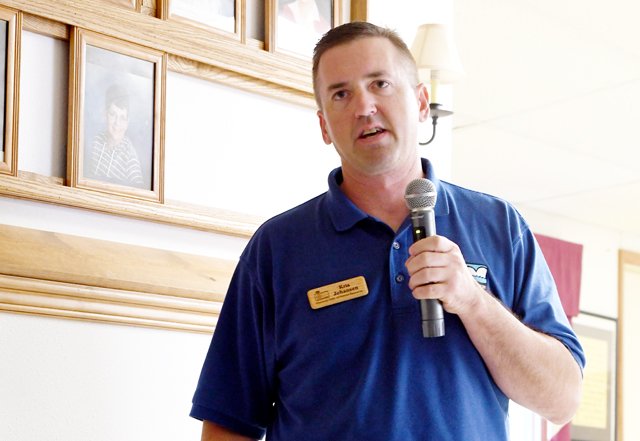

“We’d been hearing about the disease from our colleagues out in Colorado and Wyoming for years, starting in 1978,” WDNR West Central District Wildlife Supervisor Kris Johansen told the almost 40 people at the Wilton event. “We were on high, red alert by the time we found our first positives – it was three, two-and-one-half-year-old bucks, in 2001, in a three-mile radius area in western Dane County. In 2022, Dane County’s prevalence of CWD among bucks is 40 percent.”
Johansen told meeting participants that the disease is more prevalent in mature bucks than young bucks, and more prevalent in bucks than does.
“Signs of the disease are skinny ribs, no fear of humans, inability to stand, drooping head and ears, and drooling,” Johansen explained.
Johansen said that CWD can be transmitted directly from deer to deer, but also indirectly through the soil and into plant material. For this reason, he emphasized, it is important to remove your harvest from the landscape and dispose of your carcasses in a CWD dumpster or a landfill that accepts carcasses.
“Lesson learned over the last 20 years of surveillance and monitoring of prevalence of the disease is that there is no silver bullet that is going to work to stop the spread,” Johansen said. “The most effective ‘tough medicine’ approach is aggressive herd reduction, but this approach would require socio-political support, and surveillance and monitoring is very expensive.”
Johansen pointed out that in the past, WDNR had a couple of tools that had proved very effective for herd reduction and controlling the spread. Two of those tools were the ‘Earn a Buck’ program, and the special October antlerless hunt.
“We have achieved some successes, however,” Johansen said. “One success is an increase in community engagement like this session to promote awareness and best management practices. Another is our rapid turn testing process, where hunters can submit their deer for sampling and get their results back very quickly.”
Johansen also pointed to growth in community partnerships to sponsor sampling kiosks and dumpsters for carcasses. He said that partnerships with local meat processors who accept deer donations, and process them for distribution to local food pantries has also been a very successful program.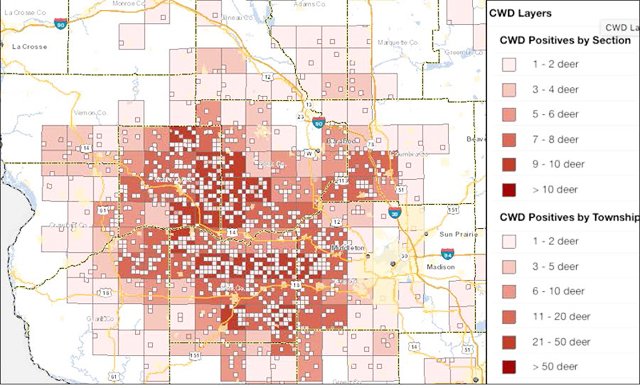

Local prevalence
Last year, Monroe County had its first CWD positive test results come back for three deer in the Norwalk-Wilton-Kendall areas in the county.
In Crawford County, in 2021, 412 deer were submitted for sampling, and 23 came back positive for CWD. In 2020, 446 deer were submitted for sampling, and 17 came back positive. The county’s first positive result came in 2015, when 29 deer were sampled, and one was positive. Another positive test came in 2016, two in 2017, nine in 2018, and three in 2019.
In Vernon County, in 2021, 670 deer were sampled and 20 tested positive. In 2020, 735 deer were tested, and 15 were positive. The county’s first positive result came in 2017, when 477 were tested and three were positive. In 2018, 751 were tested and 11 were positive. In 2019, 800 were tested and eight were positive.
In Richland County, their first positive came in 2002, and numbers of positives really began to grow since about 2012, when 592 were tested and 18 were positive. In 2013, 227 tested and 10 positive. In 2014, 256 tested and 13 positive. In 2015, 377 tested and 37 positive. In 2016, 470 tested and 61 positive. In 2017, 855 tested and 87 positive. In 2018, 1,393 tested and 187 positive. In 2019, 1,458 tested and 246 positive. In 2020, 1,553 tested and 304 positive. And in 2021, 1,311 tested and 278 positive.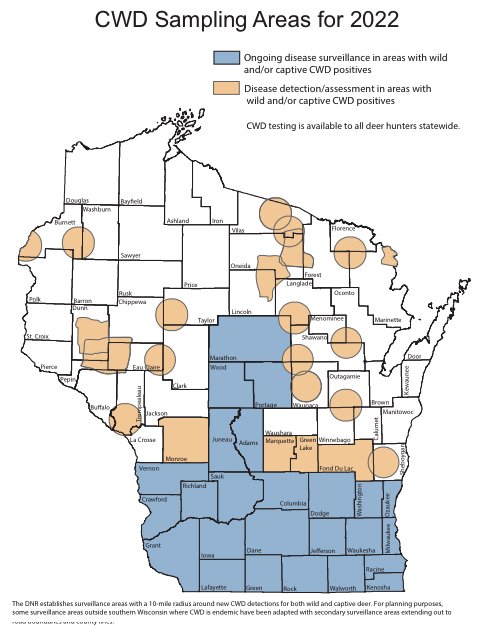

Management Plan
Johansen discussed the State of Wisconsin CWD Management Plan. The current plan is in effect from 2010 to 2025, with a review every five years. He said the most recent five-year review had begun in August of 2021, and would be released soon.
The Response Plan Review Committee includes state and national deer hunting interests, statewide science and policy interests, statewide CWD cooperators, business interests, tribal interests, WDNR staff and technical support staff.
The objectives of the plan are:
• prevent new introductions of CWD in areas where the disease is not currently believed to be present
• monitor for and respond to new areas of CWD infection
• minimize geographic distribution and intensity of CWD
• increase public recognition and understanding of CWD risks, and participation in disease control efforts
• address the needs of WDNR’s customers
• enhance the scientific information about CWD.
“As far as 2022 sampling plans, we will continue to sample on an ongoing basis across the southern tier of counties, and up the Wisconsin River corridor into Juneau, Adams, Portage, Wood and Marathon counties,” Johanson said. “In the northern part of the state, we will focus on sampling in the vicinity of a positive test in spot locations.”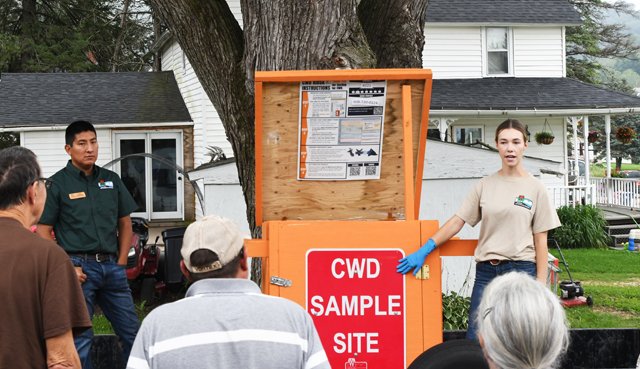

Lymph node removal
CWD Wildlife Biologist Nicole DeMarb, who covers LaCrosse, Monroe, Vernon and Crawford counties, along with Paul Napierala, WDNR Wildlife Biologist for LaCrosse and Monroe counties, took the group outside to demonstrate how to use a CWD sampling kiosk, and how to remove lymph nodes from a deer.
“When you drop your deer head or lymph node samples at a kiosk, it is important that you have all the information you will need with you so you don’t make a wasted trip,” DeMarb said. “Another option would be to pick up a packet in advance of your hunt, fill it out at home, and then bring it all to the kiosk at the same time.”
DeMarb emphasized that the most convenient way to submit your sampling information is online, when you register your deer.
“If you complete the submission process online, including using a map where you can identify the location of your harvest just by clicking on the map, then when you bring your head to the kiosk, you can simply check a box on the form saying you submitted your information online,” DeMarb said. “This is much easier for the hunter, and much easier for us.”
DeMarb said that the pickup days and times will be posted on the kiosk where you drop off your deer head. She said that if it’s going to be quite a while before the next pick up time, you can always give her a call, and she will make arrangements to get out to the kiosk sooner so you get your results back sooner. DeMarb can be reached at 608-720-0124.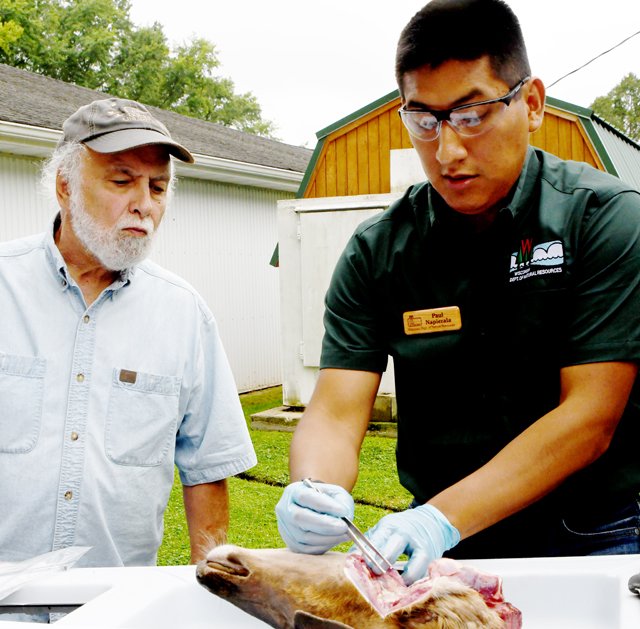

Both DeMarb and Napierala demonstrated removal of lymph nodes from two deer heads like the experienced professionals they are. The key is to position your deer with the underside of the head and neck exposed, and stretch the neck out to make the selection of the spot for the cut easier.
Both emphasized wearing gloves when the lymph nodes are removed, and sanitizing your equipment and cutting surfaces with bleach after performing the extraction. They suggested that a dedicated cutting tool might be in order, to prevent potential contamination of meat from the animal.
“What you want to do is find the bottom of the jaw, and find the deer’s Adams apple, and make your cut, from ear-to-ear, just below the bottom of the jaw,” Napierala said. “Once you have the area opened up, the lymph nodes, one on each side, can be located just below the jaw line on the outside of the area.”
Napierala said that people sometimes become confused about what tissue is the lymph node. He said that unlike connective tissue, which will be soft and all white, or muscle tissue, which will be soft and all red, the lymph nodes have a firmer texture, and are white on the outside and a darker color in the middle.
“Once you have the lymph nodes removed, place them on a cutting surface, and cut them in half,” Napierala said. “One half of each node should go into each of the two bags provided in your sample kit – it’s okay to freeze the nodes before dropping them off at the kiosk too.”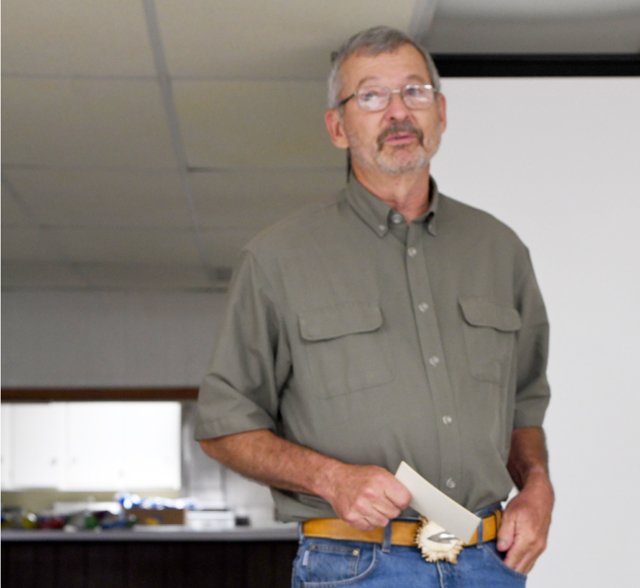

Landowners speak
Two Monroe County landowners, avid deer hunters, and CWD Task Force members, spoke to the group about their management goals and tactics for curbing the spread of CWD on their land.
Rick Case is an Ontario-area landowner who said he’d acquired his property for the purpose of deer hunting. At times during earlier presentations at the Wilton event, he’d expressed some level of frustration with what he perceived as WDNR’s level of action to stop the spread of the disease.
“I know your hands are tied, but surveillance and monitoring just aren’t enough,” Case said. “This disease is spreading further and faster every year, and I think we need an aggressive herd reduction strategy. We need to let the WDNR biologists manage this epidemic.”
Case also referenced legislation, sponsored by Congressman Ron Kind, that continues to move through the U.S. Congress.
In April of 2022, Rep. Ron Kind announced that his bipartisan Chronic Wasting Disease Research and Management Act is one step closer to becoming law after companion legislation was introduced in the Senate by Senators Heinrich (D-NM) and Hoeven (R-ND).
The Chronic Wasting Disease Research and Management Act will help combat chronic wasting disease (CWD) by funding research into CWD prevention and supporting state and tribal efforts to develop and implement management strategies for the disease.
Representative Kind introduced the Chronic Wasting Disease Research and Management Act in October 2021 and the legislation passed the House of Representatives with overwhelming bipartisan support in December 2021.
Case also said that he is frustrated with the ‘CWD denial,’ and all the crazy conspiracy theories that he hears from fellow hunters about the disease.
“It’s not a conspiracy,” Case said. “CWD is here, now, and it’s real!”
He said that he has had a lot of success in talking to women about the CWD testing issue. When he asks them if their family gets their deer tested, and they answer “no,” he asks them “why not.”
“You feed your family chicken, pork and beef from the store that has all been tested to guarantee safety,” Case tells them. “Why wouldn’t you want to get your deer tested so you know the meat you’re feeding your family is safe.”
Case says it is his opinion that there are too many deer in general right now in the southern farmland district, and he emphasized that “it is the young bucks that spread it, and the old bucks that die of it.”
“CWD has become too political – most of those legislators wouldn’t know a deer from a prairie dog,” Case said. “Landowners need to take matters into our own hands if we’re going to turn this situation around.”
“We need to get more deer shot, plain and simple,” Case said. “If the state won’t allow an Earn-a-Buck program, then you can have one on your own private property, and require people who hunt your land to shoot a doe if they shoot a buck.”
Case also lauded the food pantry donation program, but said that processors need to be paid more for it if we want more processors to participate.
Chad Ziegler
Chad Ziegler is the Monroe County forester and an avid deer hunter. He says that he and his family eat lots of deer meat year round, and a healthy deer herd is very important to him.
Ziegler said that his goal with his property is to confine the deer herd to WDNR’s stated optimal concentration of about 35 deer-per-square mile. He said that one thing he does while he is out deer hunting is to observe the number of deer he sees, and record those numbers. He says this exercise helps him to ground truth data that WDNR provides about deer herd density. He said that trail camera surveys can also be very helpful.
“Herd reduction is best done as a group project in a neighborhood, a valley or a township,” Ziegler said. “If you are just focusing on your land, what you’ll find is that the next year, no matter how aggressively you’ve hunted your land, you’ll have the same number of deer because deer will shift around to fill a vacuum.”
Ziegler said he has also had good luck running his own deer donation program, donating to friends, neighbors and family.
“There’s lots of people out there that don’t hunt, but would be happy to receive a deer,” Ziegler said.
Ziegler said his deer management goals for his property is to support a healthy deer herd, with normal growth/body functions, and disease and parasite resistance. He said he wants to see more mature bucks, and focuses his land management on creating food, and a healthy habitat through regeneration and native plants.
“In the past, my antlerless management goals on my land were to take 12-15 antlerless deer,” Ziegler said. “But since CWD has been detected in Monroe County, I’ve upped my antlerless harvest goals to 20-25 deer.”
Ziegler emphasized the importance of keeping the carcasses of infected animals off the landscape. He says that he processes all his deer by deboning them, keeping the carcass of each animal separate, and placing the meat in separate totes in the refrigerator.
If the CWD results come back negative, then he places the bones on his ‘bone pile.’ If the result comes back positive then he takes the carcass to a landfill or dumpster. He said if you can’t take it to a dumpster, then you should bury it, or return the carcass to the location of the harvest.




